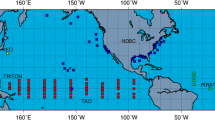Abstract
During summer Monex-79, a variety of observing systems viz. research ships, research aircrafts, constant pressure balloons and geostationary satellite etc. were deployed, besides the regular conventional observations. The purpose of these additional systems was to make the best possible data for the studies on various aspects of monsoon circulation. The present study is aimed at the construction of vertical wind profile using cloud motion vectors obtained from GOES (I-O) satellite and to examine whether the constructed wind profiles improves the representation of the monsoon system, flow pattern etc. in the objective analysis. For this purpose, climatological normals of the wind field are considered as the initial guess and the objective analyses of the wind field are made with, first using only data from conventional observations over land areas, subsequently including the constructed winds from cloud motion vectors. These analyses are then compared with the standard analyses of wind field obtained from Quick Look Atlas by T. N. Krishnamurti et al. (1979).
It is inferred that satellite estimated mean wind profiles show good agreement with the mean wind profiles of the research ships with RMS errors less than 5 mps below 500 hPa and less than 8 mps above 500 hPa. It is further inferred that the inclusion of constructed winds shows a positive impact on the objective analysis and improvement is seen to be more marked in the data-sparse region of the Arabian sea. Analyses which include the constructed winds show better agreement with the standard analysis, than the analyses obtained using only conventional winds. Thus, results of our study suggest that the wind profiles constructed using cloud motion vectors are of potential use in objective analysis to depict the major circulation features over the Indian region.
Similar content being viewed by others
References
Begum, Z. N. and Datta, R. K. (1986), A model for deriving vertical wind profile over Indian seas using cloud vector winds,Vayu Mandal,16: 53–55.
Begum, Z. N. (1986), Modelling of wind profile over the Arabian sea,Mausam,37: 537–538.
Cressman, G. P. (1959), An operational objective analysis system,Mon. Wea. Rev.,87: 367–374.
Hamda, T. (1988), Prospects of satellite wind sensing systems in the years 1995–2000,Met. Sat. Ctr. Tech. Note.,16: 1–8.
Joshi, P. C. Kishtwal, C. M. Narayanan, M. S., Sharma, O. P. and Upadhyay H. C. (1987), Assessment of the use of satellite derived winds in monsoon forecasting using a general circulation model,Adv. Space. Res.,7: 11, 353–356.
Krishnamurti, T. N., Greman, P., Ramanathan, Y., Pasch, R., and Ardanuy, P. (1979), Quick Look Summer Monex Atlas, Part II — The onset phase, Florida State University, Report No. 79-5, 1–205.
Mahajan, P. N. and Deshpande, V. R. (1986), Satellite-derived cloud motion vectors for monitoring lower and upper tropospheric monsoon circulation during summer Monex-1979,Vayu Mandai,16: 6–9.
Mahajan, P. N., Mujumdar, V. R. and Ghanekar, S. P. (1986), The burst of Indian summer monsoon as revealed by GOES satellite during Monex-1979,Adv. in Atmos. Sci.,3: 514–519.
Mahajan, P. N. (1987), Satellite-observed upwelled region and prime eddy off somali coast during Monex-79,Proc. Indian Acad. Sci. (Earth Planet Sci.),96: 41–47.
Mahajan, P. N. and Nagar, S. G. (1987), Comparison of low-level satellite winds and surface winds observed by research ships during summer Monex-1979,Mausam,38: 445–448.
Mahajan, P. N., Mujumdar, V. R. and Ghanekar, S. P. (1989), Excitation of low-level jet as seen by GOES (1-0) satellite off the Somali coast,Adv. in Atmos. Sci.,6: 475–482.
Rajamani, S., Talwalkar, D. R., Upasani, P. V., Sikka, D. R. (1982), Impact of Monex-79 data on the objective analysis of the wind field over the Indian region,Pageoph,120: 422–436.
Simon, B. and Desai, P. S. (1986), Equatorial Indian ocean evaporation estimates from operational meteorological satellites and some inferences in the context of monsoon onset and activity,Bound. Layer. Meteor.,37: 37–52.
Wylie, D. P. and Hinton, B. B. (1981), Some statistical characteristics of cloud motion winds measured,Mon. Wea. Rev.,109: 1810–1812.
Yadav, B. R. and Kelkar, R. R. (1989), Low-level wind flow over the Indian ocean during the onset of monsoon-1989,Mausam,40: 323–328.
Author information
Authors and Affiliations
Rights and permissions
About this article
Cite this article
Mahajan, P.N., Talwalkar, D.R., Nair, S. et al. Construction of vertical wind profile from satellite-derived winds for objective analysis of wind field. Adv. Atmos. Sci. 9, 237–246 (1992). https://doi.org/10.1007/BF02657514
Received:
Revised:
Issue Date:
DOI: https://doi.org/10.1007/BF02657514




